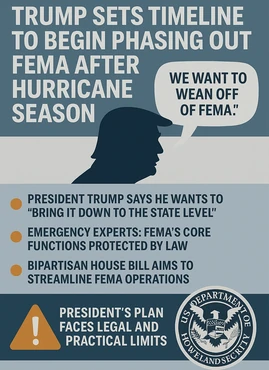States should take a stronger role in preparing for, and recovering from, disasters, Trump says
June 17, 2025
- President Trump says he wants to “wean off” the federal disaster agency in favor of state-led response
-
Emergency experts say FEMAs core functions are protected by federal law and cant simply be eliminated
-
A bipartisan House bill aims to streamline FEMA operations, not dismantle them

President Donald Trump has reiterated his intention to downsize the Federal Emergency Management Agency (FEMA), this time offering a timeline. We want to wean off of FEMA, and we want to bring it down to the state level, Trump told reporters during a June 10 briefing in the Oval Office. Bloomberg News reported. The phaseout, he said, would begin “after hurricane season.”
This statement has reignited a long-running debate over the role of federal versus state governments in disaster response. FEMA, founded in 1979 by executive order and later codified into law under the Stafford Act of 1988, plays a central role in the U.S. response to hurricanes, wildfires, floods, and other disasters. While critics of FEMA point to its bloated bureaucracy and soaring costs, emergency management professionals say its core functions are not something a president can simply erase.
No. Not even Trump can resist the blowback of not helping out after an event like Hurricane Katrina, said Craig Fugate, who served as FEMA administrator under President Obama. And the states that are the frequent flyers in the disaster program are all Republican dominated.
House draft pushes for reform, not elimination
While Trump suggests scaling back FEMAs role, a bipartisan bill from Rep. Sam Graves (R-MO) and Rep. Rick Larsen (D-WA) seeks to improve the agency’s efficiency rather than dismantle it. The proposed legislation would amend the Stafford Act to simplify FEMAs cumbersome reimbursement process and require local governments to take more responsibility for long-term resilience.
For example, the bill would allow communities to receive upfront project estimates akin to an insurance payout instead of navigating years of post-disaster audits and paperwork. It also includes tougher requirements for disaster-hit communities to obtain insurance after receiving federal aid, aiming to reduce repeat claims.
Right now, FEMA is essentially covering recurring events, not just extraordinary ones, said Fugate. The idea was never to shift all risk to the federal taxpayer.
The draft legislation also proposes that FEMA could directly fund basic home repairs for primary residences a shift from current practice, where the agency typically provides expensive temporary housing or patchwork solutions, like $10,000 tarps for damaged roofs.
Limits of presidential power
Despite Trumps ambitions, legal experts emphasize that FEMAs key responsibilities are mandated by Congress and not subject to unilateral abolition. The Stafford Act requires the federal government to provide assistance in declared disasters, especially when state resources are overwhelmed.
FEMA also functions as a supporting agency rather than the lead actor in emergencies. Most states legally empower their governors to oversee disaster response, with FEMA coordinating federal resources when requested.
The more states rely on FEMA as the primary responder, the more you lose the resilience of the country, Fugate warned, noting that encouraging states to build their own capabilities is wise but FEMA will remain essential, especially for large-scale catastrophes.
Whether Trumps FEMA phaseout rhetoric leads to genuine reform or just fuels political debate, the agencys future will likely be shaped more by congressional action than by presidential pronouncements.
#Trump #sets #timeline #phasing #FEMA #hurricane #season